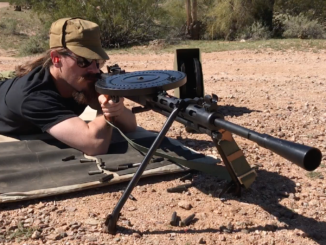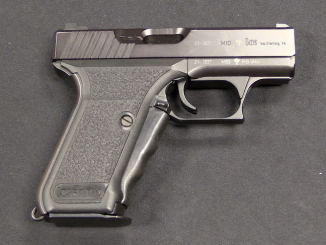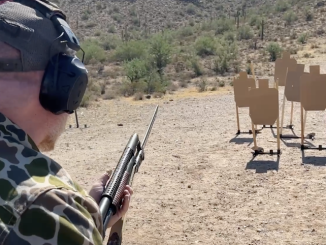Today, may the good lord help me, I am taking the Zip 22 out to the range for some shooting.
Note that while it actually worked remarkably well right up until it jammed solid, on the second range trip when we went back to get the high-speed footage, we literally could not get two rounds in a row. We did get a couple neat high-speed malfunctions though…
A big thanks to reader Matt for generously loaning me the gun to film!




Here is an idea: Two gun match with the Zip 22 and Cobray Terminator! Everyone has to use this combo and the first one that actually completes the course – regardless of time or shot count – Wins!
“Zip 22”
I think that gun like this deserve appropriate backronym, I propose Zealously Inefficient Pistol and I am waiting for others.
On the name, as I’m sure Daweo knows (as as does Wiki), in U.S. slang a “zip gun” is an improvised firearm, often .22LR, often single shot, possibly one shot; accuracy optional.
So by branding this thing the “Zip 22”, the manufacturer unaccountably set a disparagingly low expectation in the mind of potential buyers …
… and then fell short of it.
Bewildering bit of marketing, but it probably helped minimize the number of unhappy buyers.
a 3d printed or cast metal bolt would have helped, perhaps
I agree. I suspect that a bolt cast of zamak 3 rather than polymer would help the reliability, and still be inexpensive to manufacture. But it would still be a miserable design.
As I suspected, this is a failure to use modern tech to do anything other than look cool.
Given a choice of “terrible handguns,” which would be best for a “get your mitts off me” type of dark alley shuffle?
1. Zip 22
2. Langenhan FL
3. Type 94 Nambu (late production)
4. Glisenti 1910
5. Rohm RG10
6. Jennings J-22
7. None of the above, get a Bowie knife!
Glisenti
With the correct ammo
🙂
I bet on Langenhan FL, if it is not weary and you know anyone who assembled it last time know about importance of doing this process correct way. While that… self-disassembly possibility is well known, I do not heard about other problems with reliability (jams, failure to eject, etc) happening more frequently than normal, so with mentioned conditions full-filed it should work.
Would the Roth-Sauer pistol also beat the Zip 22 in reliability and “stopping power” factor?
Come on We all know that in a close-up self-defense situation that a good rock or a brick would be both more reliable and have better stopping power (since if the Zip 22 did fire it would probably miss).
“Roth-Sauer pistol”
This automatic pistol: http://www.hungariae.com/RothSau.htm ?
So far I know it has not particular problems with reliability, though it was unnecessary complicated.
This is pretty easy to answer. The obvious choices would be Glisenti 1910 or Type 94. They fire the most potent cartridges of the lot, and despite poor reputation and terrible finish on the Type 94, both would probably empty their magazines without incident. Assuming fairly little used or repaired by a competent gunsmith examples, of course. The Glisenti would require ammunition that confirms to the Italian military 9mm Glisenti specifications, which meant MV of no more than 320 m/s and a truncated cone bullet. It would NOT feed reliably with conventional round nose FMJ bullets.
From the rest I would probably take the RG10, because it’s a revolver. It would possibly be out of time straight from the factory, but it would probably work well enough to empty the cylinder.
I actually had an rg 10 and 14 that both operated perfectly with regular use and carry (I was extremely poor and worked delivery at night going to some legit crack dealer neighborhoods). I know I was the rare exception but it is possible.
Was there really anything seriously wrong with the Rohms that weren’t .357 Magnums or .44s?
Sure, they aren’t Colt Pythons or classic Smiths. But you can’t even buy anything of that calibre anymore.
The biggest problem seems to be that they were quite often out of time or “shaved lead” when fired. That does not mean every example was like that. DA pull was reportedly very heavy, which might be a problem in a self-defense scenario. Mind you, this is all second hand information. “Saturday night specials” are very rare in Europe due to the gun laws, which either don’t recognize or severy limit gun ownership for self defense purposes.
Glisenti. With 9mm +P. The first shot probably won’t hurt you that much, and you might get a second or third.
I would go with a Bulldog in 44 Special – since we are belly to belly and while cheap it is a reliable revolver and the cartridge will get the job done!
It also doesn’t look cool.
Your list is missing the Rogak & R51
I also left out the Colt 2000. I need not mention the fact that it would have been better had the staff at Colt not messed with Mr. Knight’s original design.
Also, if I might add something:
http://modernfirearms.net/en/handguns/handguns-en/ukraine-semi-automatic-pistols/shevchenko-psh-eng/
“… and a very special sort of slide stop, that locked slide open once there was ONE cartridge left in the gun. The claimed purpose of this arrangement was to allow shooter to make its “deliberate last shot” – in its own head, probably.”
Wow. I wouldn’t doubt it… going into a gunfight with something like this!
or a hawk or a kukri. kind of.
how about that and that cobray terminator as an arsenal. wouldn ‘t ya feel well wrmed with that combo?
Looking at the bolt
I was thinking that it is too short to be able to guide itself in the receiver…
But of course, it is guided on the spring guide rods, so from the point of view of guiding, it only needs to be as long as the diameter of the guide rod holes.
Now, in the extremely unlikely event that someone wants to make one of these things work sort of reliably (it really is much safer if it won’t fire)…
There are high density, machineable tungsten alloys, available for making things like electrodes for electric discharge machining.
The alloys have densities of upto about 18 grams / cc
(18 times the density of water, and about half as dense again as lead)
The gun needs things to happen a lot,lot slower than they are currently happening with that polymer bolt.
With a much heavier bolt, there will be a need for weaker springs, to allow the bolt to cycle far enough to pick up the next round.
These links give refs for designing and winding new coil springs
https://www.thehighroad.org/index.php?threads/making-a-magazine-spring.463115/#post-5766199
Th
https://www.practicalmachinist.com/vb/general/universal-spring-winder-195372/
You’ll probably need to do some trial and error work to get the correct balance between bolt mass and spring rate for reliable cycling.
More bolt weight and less spring force will smooth everything out and slow it all down.
It’s a long time since I’ve had hold of a Ruger 10/22 mag. I can’t even remember whether it’s possible to disassemble the things
(Impo the 10/22 was a way over priced, over rated and over weight pos in Europe, compared to a good Browning, CZ or gevarm semi auto…)
If you can disassemble the plastic POS of a mag, think about making a stronger spring for it.
“The alloys have densities of upto about 18 grams / cc”
I am wondering what is density of actually used polymer bolt?
After some search I found: https://scientificpolymer.com/density-of-polymers-by-density/
which shows 2.15 as density of most dense polymer, which is less even than light alloys (for example Hiduminium R.R.56 has density 2.75) not to mention heavier metals:
https://www.engineeringtoolbox.com/metal-alloys-densities-d_50.html
(notice that you need to divide density by 1000 from that table)
brass and bronze have density in range of 7…9, steel 7.85, so possibly “common” metal would suffice to slow down? Yet it would have advantage over tungsten in terms of price.
Anything denser and stronger than polymer would be preferable for the bolt
Starting from
Bullet mass × bullet velocity = bolt mass × bolt velocity
If we take the bolt in the 10/22 as a starting point (and ignore the binding due to the off centre return spring and the funny angles rear of the receiver in the 10/22)
Simply proportioning the bolt weight to the barrel lengths…
I’m guessing is going to give us an over long bolt in for example free machining mild steel. The next materials are things like free machining stainless with about 50% greater density compared to ordinary low alloy steels and phosphor bronze at about the same density as the stainless
The machineable tungsten alloys are actually ok to machine
They’re intended to be used for electric discharge machining electrodes for sinking complex dies into hardened steels,
So they’ll machine to a good finish without requiring exotic cutters.
With that short bolt and short overtravel, I think that the more mass you can put into it the better
At this stage it’s individual owners who will be modding their own shite guns
Twenty thirty or fifty bucks worth of machineable tungsten alloy is cheap imo compared to the price of the POS plastic fantastic
I forgot to question what filler got used in the plastic fantastic moldings
Hopefully it was something like calcium carbonate (limestone / chalk/ precipitated calcium carbonate ) rather than something hard and abrasive like silica
In the mid 2000s I bought a little olympus digi cam and the lump of plastic on the cord hand loop was filled with something abrasive
It absolutely ate the stainless steel trim on that little camera’s body
The way around any abrasive filler in the plastic housing
Is to avoid contacting the plastic
Linlithgow contact to the guide rods, just like the AR18 / AM180 does.
Limit contact to the guide rods…
Feckin autoincorrect
Mud Test?
If the mud embEdstaston in the polymer bolt, it will spend the rest of its life eating the bolt guide rods.
Forget about mud tests, keep it as clean as possible
If the mud embeds
Damn the auto incorrect
So how did the Remington 66 with nylon bolt work so well?
According to https://warisboring.com/the-remington-nylon-66-was-the-first-plastic-gun/
patent(…)describes Remington’s aims(…)principal object of this invention is the provision of a new and improved firearm which can be manufactured and assembled with great economy. At the same time, it is one of our objects to provide for improved functioning of such a firearm through the utilization of unconventional materials providing bearing surfaces of exceptional efficiency.
Also it was actually well tested before production started:
Remington began testing the first prototype in 1955, paying particular attention to possible structural weaknesses during the initial, 75,000-round firing test. Testing continued through 1958.
The Remington 66 has a steel bolt
I’m not sure what filler material was used in the combined polymer stock and receiver of the 66.
Remington advertising claims that the material is self lubricating.
I’ve forgotten the details, there is something about the “nylon” poly amides having a surface layer of bonded, or at least attracted, water molecules that result in them having low friction characteristics.
The structure of the molded combination of stock and receiver in the nylon 66 unfortunately has very poor resistance to bending and twisting
The thin sheet steel cover is not a true structural part, it is a legal formality, that carries the serial number
The twisting of the nylon structure can be sufficient for a loaded gun being carried slung over a person’s back, to go off
At least one case that I know of, resulted in someone getting a bullet in the back of his brain. He’d slung the rifle to cross a drainage ditch.
Tube magazine rifles are not the easiest guns to unload before you cross an obstacle, and that encourages dangerous acts like slinging a rifle that has a round in the chamber
One of the things that I love about the Gevarm, is that as soon as the magazine is out, the gun is safe. There’s no chasing about after an ejected round.
Coming back to the Remington 66, the trigger mechanism is probably the only semi auto trigger that uses an over-ride sear
And probably the only fire control that uses coil springs in tension
There are very good reasons why those features are so unusual… it’s because most gun designers, design their guns to be as safe and as reliable as possible. For examples Browning, designed in multiple levels of redundancy in his safety features.
Smith and Wesson revolver trigger mechanisms have multiple levels of safety, ensuring that the guy can only fire when the trigger is deliberately pulled and kept pulled.
The auto safety on a side by side shotgun positively re sets the triggers into their forward positions
“Best” (and many lesser price) side by side shotguns have “safety sears” that have their mass in the opposite direction to the firing sears
So if the gun is subject to a bump that tends to rotate the firing sear out of its notch, the safety sear will not be rotated and will intercept the internal hammer and prevent it from firing the cartridge.
Remington’s post WWII designers did not have the background to design in those kind of features, and it shows
The nylon 66, a gun that can go off just from the distortion of being on a sling on someone’s back
The Walker trigger (a collection of parts flying in loose formation) even gave accidental discharges in the few pre production examples leant out to “Mike” Walker’s bench rest pals.
The Barbour collection of Remington documents shows that Walker alerted Remington management to the problem in a memo, ahead of the trigger going into production. The management ignored it, and subsequently suppressed public knowledge of the danger by non disclosure orders on any court or out of court settlements
The safeties used with the “walker” trigger, rapidly wore to the point where if the trigger was pulled with the safety on, there was not enough clearance for the trigger to re set, especially if the “adjustments” that were there to allow the low tolerance parts to be adjusted to work during assembly, had been used to achieve a light trigger pull. The rifle would then fire when the safety was released
Until a recall to grind off the bolt locking tab from the safety, the safety had to be taken off to open the bolt
What is a safe direction to point an unsafe rifle?
The safety problem was exacerbated in the version of the Walker trigger with the two sides by side sears, which wore even more rapidly.
The Remington common fire control, used on pumps and semi autos, bears a striking resemblance to a 1940s era general motors car door catch (Remington’s post war designers were GM engineers, not experienced gun designers like Browning). Its “safety” simply disconnects the trigger
It doesn’t actually lock anything.
And the hole at the bottom of it? That was an afterthought to allow debris to leave the fire control, rather than to gum it up.
to Keith in England:
“The thin sheet steel cover is not a true structural part, it is a legal formality, that carries the serial number”
Not so. My dad’s first Nylon 66 had no serial number. The legal requirement that new guns be serialized did not come until later.
“The twisting of the nylon structure can be sufficient for a loaded gun being carried slung over a person’s back, to go off”
Remington never offered sling swivels for the Nylon 66. I never saw one with a sling. After having one bouncing around in the back window gun rack of our ranch pickups for years with no problems, I must rate the Nylon 66 as safe, reliable and pretty much indestructible.
To Jim in Texas,
Whether Remington fits sling swivels or not
Slinging is normal use for a rifle
A rifle that is designed so flexible that Slinging risks you getting a bullet in the back of your head,
Is a rifle that is dangerous by design
Maybe that’s just me and how I use a rifle. I have 14 rifles at last count and only one has a sling on it.
Keith in England: Where is a reference to the Remington Nylon bending under slung tension? I actually remember when these were introduced and I do not recall this story until you mentioned it in these comments. I have not seen anyone else saying they have seen/experienced this effect. I am also unaware of any product recall (which would definitely occur here in the USA if documented) for this problem.